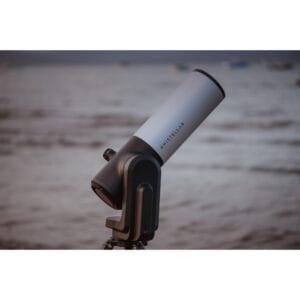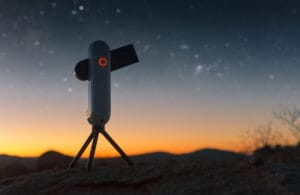
(Main image: Robert Lea (created with Canva))
This year, Earth will temporarily get a second “moon” when a small asteroid will orbit our planet. This mini-moon will be visible from late September for about two months, until late November. It’s a rare phenomenon that occurs occasionally when an asteroid is captured by Earth’s gravity and temporarily orbits our planet.
The asteroid, named 2024 PT5, was discovered in August by researchers from the ATLAS program (Asteroid Terrestrial-impact Last Alert System), which uses instruments in South Africa to monitor asteroids. Scientists from the Universidad Complutense de Madrid have studied the asteroid’s orbit and determined that it will orbit Earth between September 29 and November 25.
What is a Mini-Moon?
A mini-moon occurs when an asteroid is temporarily captured by Earth’s gravity and enters orbit around the planet. These objects usually remain in Earth’s orbit for only a short time before finding their way back to the Sun. In the past, there have been several mini-moons, such as 2020 CD3 and 2022 NX1, both of which temporarily orbited Earth before continuing their journey through the solar system. Scientists refer to it as “gravitational capture” when objects like 2024 PT5 are pulled into Earth’s gravitational field.
What distinguishes these mini-moons from the permanent moon is that they don’t make complete revolutions around Earth like our real moon. Like 2024 PT5, they only stay briefly and often move in complex orbits, such as horseshoe-shaped trajectories, before being released to continue their journey through space.
The Orbit of 2024 PT5
The asteroid 2024 PT5, originating from the Arjuna asteroid belt, will move in a horseshoe-shaped orbit around our planet due to Earth’s gravitational pull. This is because the asteroid has negative geocentric energy, meaning it stays within Earth’s gravity. After 56 days, the asteroid will break free from Earth and return to its orbit around the Sun. This mini-moon won’t behave like a classic satellite orbiting Earth, but rather like a “window shopper” that comes close to us without fully settling into a stable orbit.
The term “mini-moon” is often used to describe objects like 2024 PT5, but in fact, they often follow a much more complex route. Instead of a perfect circular orbit, this object moves in a horseshoe shape and will never completely orbit Earth. This makes the mini-moon phenomenon unique and particularly interesting for astronomers.
Scientific Significance
The mini-moon phenomenon like 2024 PT5 gives scientists the opportunity to better study the interaction between celestial bodies and planetary gravity. Although these objects are usually relatively small and difficult to see, they help astronomers learn more about the dynamics of objects in our solar system. Carlos de la Fuente Marcos, professor at the Universidad Complutense de Madrid, explains that objects from the Arjuna asteroid belt often exist at small distances from Earth, with speeds of only 3,540 km/h. Under the right conditions, like with 2024 PT5, they can be captured by Earth’s gravity and temporarily enter orbit.
Although 2024 PT5 is too small to be seen with the naked eye, binoculars, or a regular telescope, the phenomenon does provide new insights for scientists. It helps to better understand the delicate balance between gravity, velocity, and orbital mechanics.
Is the Mini-Moon Visible?
Unfortunately, 2024 PT5 will be too small to see with the naked eye, binoculars, or standard telescopes. Only with professional telescopes and specialized equipment will astronomers be able to track this mini-moon. It’s an intriguing phenomenon for scientists and space enthusiasts, but for most people, the mini-moon will remain invisible. Even after leaving Earth’s orbit, 2024 PT5 will stay near our planet until January 2025 before continuing its journey.
While we may not be able to observe this mini-moon, the fact that an object is temporarily “captured” by Earth is a fascinating example of how dynamic our solar system is. It reminds us how complex the interactions between celestial bodies can be and how space objects are constantly in motion. 2024 PT5 will appear near Earth again in 2055, meaning we might witness such a gravitational capture again in the future.
Conclusion
Although most people won’t be able to see 2024 PT5 with their own eyes, it remains a remarkable phenomenon in astronomy. The temporary arrival of this mini-moon gives us another glimpse into the wonders of our solar system. While Earth retains its faithful moon, the arrival of a mini-moon like 2024 PT5 shows us how dynamic and changeable the space around us is.
With this mini-moon, we get a brief but educational reminder of the complexity and beauty of the universe, where small objects like 2024 PT5 temporarily become part of our planetary environment.




